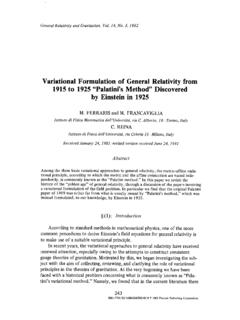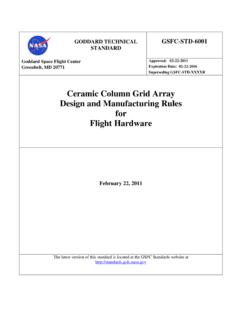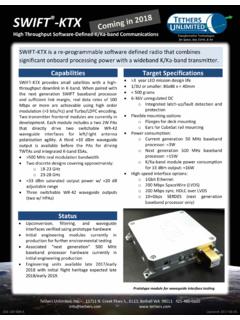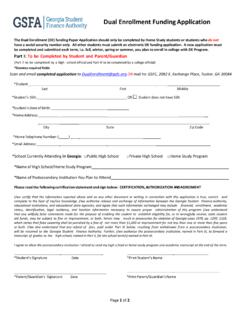Transcription of Time Dilation Near the Earth - Relativity Calculator
1 2 time Dilation Near the Earth The modern theory of gravity, called the Theory of General Relativity , developed by Albert Einstein in 1915 leads to some very unusual predictions, which have all been verified by experiments. One of the strangest ones is that two people will experience the passage of time very differently if one is standing on the surface of a planet, and the other one is in space. This is because the rate of time passing depends on the strength of the gravitational field that the observer is in. For example, at the surface of a very dense neutron star, R = 20 km and M = x 1030 kg, so T = t (1- )1/2 = t This means that for every hour that goes by on the surface of the neutron star (T = 60 minutes), someone in space will see t = 60 / = 65 minutes pass from a vantage point in space.
2 T = the time measured by someone located on a planet (seconds) t = the time measured by someone located in space (seconds) M = the mass of the planet (kg) R = the distance to the far-away observer from the planet (m) And the natural constants are: G = x 10-11 Nt m2/kg2C = 3 x 108 m/sec The following problems require accuracy to the 11th decimal place. Most hand calculators only provide 9 digits. Students may use the ' Calculator ' accessory provided on all PCs and Macs. Problem 1 - The GPS satellites orbit Earth at a distance of R = 26,560 km. If the mass of Earth is x 1024 kg, use the formula to determine the time Dilation factor.
3 Problem 2 - What is the time Dilation factor at Earth 's surface? Problem 3 - What is the ratio of the Dilation in space to the Dilation at Earth 's surface? Problem 4 - At the speed of light (3 x 108 m/sec) how long does it take a radio signal from the GPS satellite to travel 26,560 km to a hand-held GPS receiver? Problem 5 - The excess time delay between a receiver at Earth 's surface, and the GPS satellite is defined by the ratio computed in Problem 3, multiplied by the total travel time in Problem 4. What is the time delay for the GPS- Earth system? Problem 6 - From your answer to Problem 5, how much extra time does the radio signal take compared to your answer to Problem 4?
4 Problem 7 - At the speed of light, how far will the radio signal travel during the extra amount of time ? Space Math 2 Answer Key: Problem 1 - The GPS satellites orbit Earth at a distance of R = 26,560 km. If the mass of Earth is x 1024 kg, use the formula to determine the time Dilation factor. Be very careful with the small numbers in the 9th, 10th and 11th decimal places! Answer: ( 1 - m)1/2 = ( 1 - x 10-10) 1/2 = ( )1/2 = Problem 2 - What is the time Dilation factor at Earth 's surface? ( 1 - m)1/2 = ( 1 - x 10-9) 1/2 = ( )1/2 = Problem 3 - What is the ratio of the Dilation in space to the Dilation at Earth 's surface?
5 Answer - / = Problem 4 - How long does it take a radio signal from the GPS satellite to travel 26,560 km to a hand-held GPS receiver? Answer - Distance = 26,560 km x (1000 m / km) = x 107 meters. time = Distance / speed of light = x 107 m / 3 x 108 m/sec = seconds. Problem 5 - The excess time delay between a receiver at Earth 's surface, and the GPS satellite is defined by the ratio computed in Problem 3, multiplied by the total travel time in Problem 4. What is the time delay for the GPS- Earth system? Answer - seconds * = seconds.
6 Problem 6 - From your answer to Problem 5, how much extra time does the radio signal take compared to your answer to Problem 4? Answer - - seconds = seconds. Problem 7 - At the speed of light, how far will the radio signal travel during the extra amount of time ? Answer = 3 x 108 m/sec x x 10-11 sec = meters. This shows that Einstein's Theory of General Relativity is required to allow the GPS satellite system to make precise measurements of the locations of objects on Erarth's surface. Space Math








